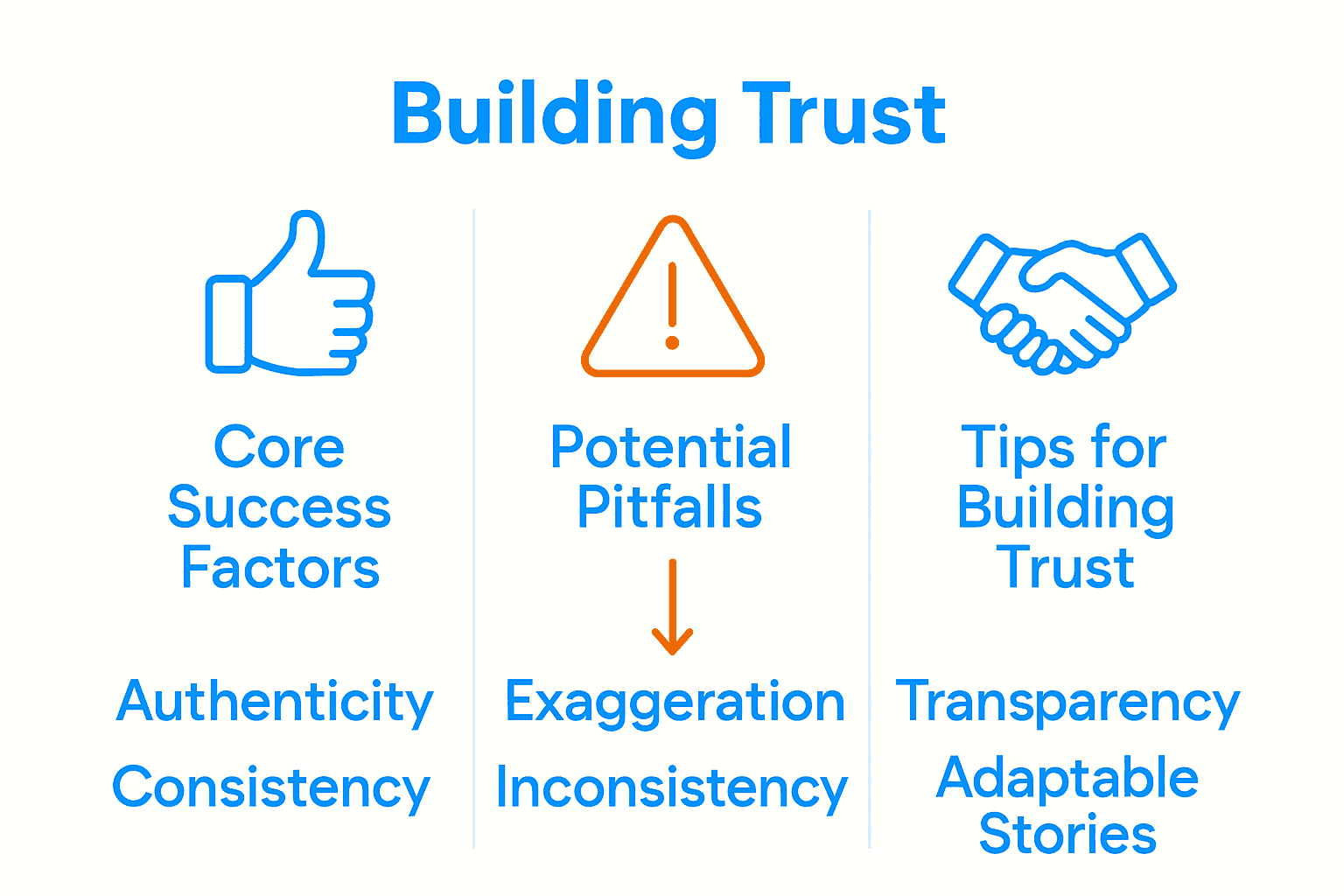Brand storytelling is transforming the way businesses connect, turning simple marketing into memorable, relatable journeys. Research shows that companies using narrative-driven strategies build up to 22 times more emotional connections with their audience. This shift matters as consumers crave authenticity and meaning from brands, not just products. Discover how clear storytelling techniques help organizations stand out, spark loyalty, and shape lasting customer relationships in a crowded marketplace.
Table of Contents
- Defining Brand Storytelling Techniques Clearly
- Identifying Major Storytelling Variations
- How Brand Storytelling Techniques Work
- Critical Success Factors And Pitfalls
- Applying Techniques Across Business Use Cases
Key Takeaways
| Point | Details |
|---|---|
| Brand Storytelling Importance | Transforming marketing into narratives creates emotional connections, engaging consumers beyond passive observation. |
| Personalization Through Technology | Generative AI enables brands to craft targeted narratives that resonate with individual consumer preferences. |
| Core Techniques for Effective Narrative | Authenticity, emotional connection, and a strong narrative arc are vital for fostering trust and loyalty in audiences. |
| Adaptability and Authenticity | Successful storytelling requires consistent, transparent narratives that evolve based on consumer feedback and engagement. |
Defining Brand Storytelling Techniques Clearly
Brand storytelling represents a strategic communication approach where businesses transform traditional marketing into compelling narratives that forge authentic connections with their audience. Unlike generic advertising, brand storytelling is about creating meaningful experiences that resonate emotionally and intellectually with consumers, transforming passive listeners into engaged participants.
According to research from arXiv, generative AI is dramatically reshaping how brands craft personalized narratives. The study highlights that modern storytelling techniques now leverage advanced technologies to develop narratives that speak directly to individual consumer experiences and preferences. This technological evolution means brands can now create more nuanced, targeted stories that feel intimately crafted for specific audience segments.
Effective brand storytelling typically incorporates several core techniques:
- Authenticity: Crafting genuine narratives that reflect real brand values
- Emotional Connection: Developing stories that trigger meaningful personal responses
- Character Development: Creating relatable protagonists (often representing customer archetypes)
- Conflict and Resolution: Demonstrating how the brand solves real-world challenges
The most powerful brand stories go beyond product descriptions, instead revealing the human motivations, challenges, and aspirations underlying a company’s mission. They transform corporate communication from transactional interactions into memorable, shareable experiences that build long-term trust and loyalty.
Identifying Major Storytelling Variations
Brand storytelling is not a one-size-fits-all approach. Different organisations leverage unique narrative strategies to connect with their audience, depending on their core objectives, industry, and target demographic. Storytelling variations offer brands flexible frameworks for communicating their message effectively and authentically.
According to research from Indeed, there are multiple distinct storytelling approaches businesses can adopt. These range from mission-driven narratives that highlight organisational purpose to customer-centric stories that showcase real-world impact. The diversity of storytelling techniques allows brands to craft nuanced communication strategies that go beyond traditional marketing.
Key storytelling variations include:
- Mission-Based Stories: Focusing on the brand’s fundamental purpose and social impact
- Customer Journey Narratives: Highlighting transformation and success through customer experiences
- Data-Driven Storytelling: Using statistical insights and visualisations to communicate complex information
- Founder’s Narrative: Sharing the personal journey and motivations behind the company’s creation
- Visual Storytelling: Leveraging imagery, graphics, and multimedia to convey brand messaging
Research from arXiv further emphasises the complexity of visual storytelling, identifying themes like character dynamics, experiential information, and narrative biases. This underscores that modern brand storytelling is a sophisticated art form requiring strategic thinking, emotional intelligence, and creative communication skills.
How Brand Storytelling Techniques Work
Brand storytelling operates as a sophisticated communication strategy that transforms traditional marketing into an immersive narrative experience. Storytelling mechanics involve carefully crafting messages that transcend simple product promotion, instead creating emotional connections that resonate deeply with target audiences. These techniques go beyond presenting facts, focusing on building genuine human connections through compelling narratives.
According to research from Online SBU, companies like Procter & Gamble and LEGO demonstrate masterful storytelling by creating narratives that showcase their brand’s values, mission, and unique personality. These organisations understand that effective storytelling isn’t about selling a product, but about sharing an experience that aligns with consumers’ aspirations and emotional landscapes.

Key mechanisms of brand storytelling include:
- Emotional Mapping: Identifying and triggering specific emotional responses
- Character Development: Creating relatable protagonists that represent brand values
- Narrative Arc: Constructing stories with clear beginning, middle, and transformative end
- Authentic Voice: Maintaining consistent and genuine communication style
- Audience Engagement: Inviting consumers to become part of the narrative
Research from arXiv further illuminates this process by introducing a framework that analyzes storytelling through critical ‘moments’ that generate emotional attachment. These moments are strategic points where brands can create profound connections, transforming passive communication into interactive, memorable experiences. For businesses looking to understand corporate branding strategies, recognising these narrative mechanisms becomes crucial for developing meaningful audience relationships.
Critical Success Factors And Pitfalls
Successful brand storytelling requires a delicate balance between creativity, authenticity, and strategic communication. Narrative effectiveness depends on multiple interconnected factors that can either elevate a brand’s message or potentially undermine its entire communication strategy. Understanding these critical elements becomes paramount for organisations seeking to develop meaningful audience connections.
According to research from Toptal, authenticity emerges as the most crucial success factor in brand storytelling. Brands that fail to maintain genuine, transparent narratives risk alienating their audience and creating distrust. This means storytelling must go beyond marketing tactics, representing the true essence of the organisation’s values, mission, and actual experiences.
Key success factors and potential pitfalls include:
- Authenticity: Ensuring narratives genuinely reflect organisational values
- Consistency: Maintaining a uniform storytelling approach across all platforms
- Emotional Resonance: Creating stories that genuinely connect with audience experiences
- Adaptability: Being willing to evolve narratives based on audience feedback
- Transparency: Avoiding exaggerated or misleading storytelling approaches
Research from arXiv further illuminates storytelling structures, highlighting the importance of segmenting narratives into meaningful units that capture audience attention. For businesses looking to craft a strong branding statement, recognising these nuanced storytelling mechanisms becomes essential for developing compelling, trustworthy brand narratives that truly engage and inspire their target audience.

Applying Techniques Across Business Use Cases
Brand storytelling transcends traditional marketing boundaries, offering versatile strategies that can be adapted across diverse business contexts and industries. Narrative application requires a nuanced understanding of how storytelling techniques can be strategically deployed to achieve specific organisational objectives, from customer acquisition to internal communication and brand positioning.
According to research from arXiv, generative AI is revolutionising how businesses approach personalised storytelling. This technological advancement enables organisations to craft highly targeted narratives that speak directly to specific audience segments, transforming storytelling from a generic communication tool into a precision instrument for engagement and conversion.
Business use cases for storytelling techniques include:
- Startup Positioning: Communicating founding vision and innovative potential
- Product Launches: Creating compelling narratives around new offerings
- Recruitment Marketing: Attracting talent by sharing organisational culture stories
- Customer Retention: Building emotional connections through shared experiences
- Corporate Social Responsibility: Highlighting impact and community engagement
Research from another arXiv study emphasises the importance of visual storytelling methods across different business scenarios. For organisations seeking to understand corporate branding strategies, these techniques offer a powerful mechanism for translating complex business narratives into engaging, memorable experiences that resonate with both internal and external stakeholders.
Elevate Your Brand Story with Custom Digital Solutions
The challenge of captivating your audience through authentic and emotionally resonant brand storytelling is one every business faces. This article highlights the importance of crafting genuine narratives that build trust and lasting connections. If you are looking to express your brand values clearly and connect deeply with your customers, a tailored digital presence is essential. At CloudFusion you can transform your story into a dynamic online experience with solutions designed to reflect your unique character and mission.
Our expertise in web development, branding and strategic content creation equips you to harness the full power of storytelling techniques discussed here. Whether you need a website that embodies emotional mapping or a development partner who understands how to engage visitors with compelling narrative arcs, we bring your purpose to life. Explore our Web Design and Development Quotations to start crafting a scalable digital platform tailored to your storytelling needs.
Ready to turn your brand story into an unforgettable journey for your audience Act now to take advantage of our custom web design and branding expertise at CloudFusion. Discover how authentic voice consistency and emotional connection can become your competitive edge by visiting our Web Design and Development Quotation page today. Your brand deserves a narrative experience as distinctive as your business.
Frequently Asked Questions
What is brand storytelling?
Brand storytelling is a strategic communication approach where businesses create compelling narratives that connect with their audience on an emotional and intellectual level, transforming passive listeners into engaged participants.
What are the key techniques of effective brand storytelling?
Key techniques of effective brand storytelling include authenticity, emotional connection, character development, and presenting conflicts and resolutions that demonstrate how the brand solves real-world challenges.
How do storytelling variations influence brand communication?
Storytelling variations allow brands to adopt unique narrative strategies based on their core objectives, resulting in more effective communication tailored to their target audience, such as mission-driven stories or customer journey narratives.
What factors contribute to successful brand storytelling?
Successful brand storytelling relies on authenticity, consistency, emotional resonance, adaptability, and transparency. Failing to uphold these elements can undermine a brand’s communication strategy and alienate its audience.








